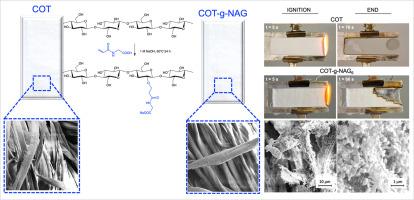Enhancing the flame resistance of cotton via N-acryloylglycine-based chemical functionalization
IF 6.5
Q1 CHEMISTRY, APPLIED
Carbohydrate Polymer Technologies and Applications
Pub Date : 2025-09-10
DOI:10.1016/j.carpta.2025.101006
引用次数: 0
Abstract
Cotton was chemically modified with N-acryloylglycine (NAG) via oxo-Michael addition under basic conditions at 50 °C, producing COT-g-NAG3 and COT-g-NAG6 with 3 % and 6 % add-ons, respectively. The goal was to graft onto cotton an analogue of the glycine-based M-GLY polyamidoamine flame retardant repeat unit. Solid-state NMR confirmed the presence and quantity of grafted NAG. SEM and X-ray diffraction analyses showed that the grafting process preserved the fiber morphology and crystalline structure. Thermogravimetric analysis revealed enhanced thermo-oxidative stability between 350 and 450 °C, compared to virgin cotton. Flame retardant performance was evaluated through horizontal (HFST) and vertical flame spread tests (VFST). In VFST, neither sample self-extinguished, but both retained substantial char. In HFST, COT-g-NAG3 showed a reduced burning rate (0.18 vs. 0.98 mm/s), while COT-g-NAG6 self-extinguished, leaving 79 wt.% residue, compared to 1 % for untreated cotton. Combustion residues exhibited a porous char typical of intumescent materials, like that observed in M-GLY coatings. These results confirm that NAG grafting imparts effective flame retardancy by inducing intumescence, without compromising cellulose integrity. The covalent nature of the grafting also enhances wash durability, minimizing leaching and environmental release. This strategy highlights the promise of amino acid-based acrylamides for the tailored-design of flame retardant cotton fabrics.

以n -丙烯酰甘氨酸为基础的化学功能化提高棉花的阻燃性
在50℃的碱性条件下,用n -丙烯酰甘氨酸(NAG)进行氧-迈克尔加成,对棉花进行化学改性,得到添加量分别为3%和6%的COT-g-NAG3和COT-g-NAG6。目的是将甘氨酸基M-GLY聚酰胺胺阻燃重复单元的类似物嫁接到棉花上。固体核磁共振证实了接枝NAG的存在和数量。扫描电镜和x射线衍射分析表明,接枝过程保留了纤维的形态和晶体结构。热重分析显示,与原棉相比,在350 ~ 450°C之间的热氧化稳定性增强。通过水平(HFST)和垂直火焰蔓延试验(VFST)对阻燃性能进行了评价。在VFST中,两个样品都没有自我熄灭,但都保留了大量的碳。在HFST中,COT-g-NAG3的燃烧速率降低了(0.18 vs. 0.98 mm/s),而COT-g-NAG6会自动熄灭,残留79% wt.%,而未经处理的棉花为1%。燃烧残留物表现出膨胀材料典型的多孔炭,就像在M-GLY涂层中观察到的那样。这些结果证实,NAG接枝通过诱导膨胀而不影响纤维素的完整性,从而赋予了有效的阻燃性。接枝的共价性质也提高了洗涤耐久性,最大限度地减少浸出和环境释放。这一策略凸显了氨基酸基丙烯酰胺在定制设计阻燃棉织物方面的前景。
本文章由计算机程序翻译,如有差异,请以英文原文为准。
求助全文
约1分钟内获得全文
求助全文

 求助内容:
求助内容: 应助结果提醒方式:
应助结果提醒方式:


